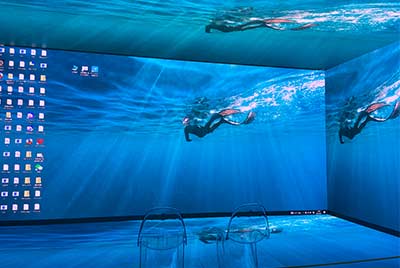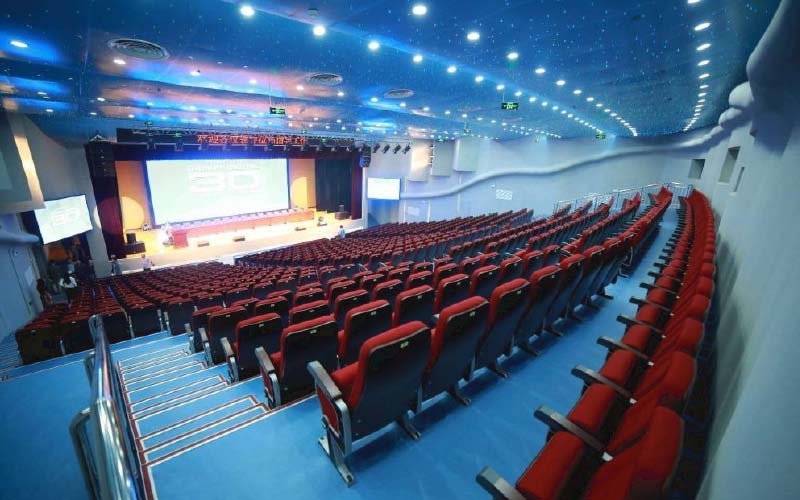 2022-04-19
2022-04-19
Ⅰ. What is HDR
We are living in a colorful world. In order to present this colorful world to our eyes through the display screen, mankind invented cameras, televisions and other equipment, and also developed many advanced technologies. HDR is one of them.
HDR is the abbreviation of High Dynamic Range, which means that the dynamic range is higher than the traditional standard dynamic range SDR (Standard Dynamic Range). This technology was applied to photography firstly. Turning on HDR during the shooting process can make the original dark scene brighter and more transparent.
At present, HDR has gradually become an increasingly popular topic, and is widely applied in display devices, photography, 3D rendering, music recording, and digital audio and video production. In fact, HDR is widely involved in all aspects of content collection, content processing, content transmission, and content production.
Ⅱ. Advantages of HDR
Take TV as an example. The range of brightness that traditional TVs can show is extremely limited, which is far from the range that human eyes can perceive. So for traditional TV, the bright part of the image cannot be increased, and the dark part cannot be darkened. This ultimately leads to the poor layering of the picture perceived by the human eye, and a lot of details are lost.
HDR display technology can perfectly solve this problem. The picture quality improvement brought by HDR is very obvious. For example, a display device that supports HDR can display more details in bright parts, and can show details in dark parts more clearly.
Compared with the mainstream SDR in the market, HDR can display more color information and more detailed textures on the same screen. At the same time, with more advanced electro-optical conversion technology, the light and dark contrast of the picture is improved, so that a picture can show the most realistic appearance.
In the Display HDR CTS V1.0 specification released by VESA on November 27th, 2017, the highest level that supports HDR display devices is defined as DisplayHDR-1000, which means that the peak brightness can reach 1000 nits. Compared with other display technologies, LED display technology naturally has the characteristics of high brightness, can express the excellent characteristics of HDR to the greatest extent, and is the best carrier of HDR technology.
The picture below shows the difference between HDR and SDR.


Ⅲ. HDR technical standards
1. HDR10

When HDR develops and becomes a usable TV technology, major home appliance manufacturers such as Samsung, SONY, and LG hope to have a more open platform than Dolby provides. It saves the royalties paid to Dolby, and there is no need to add a certification submission process to weaken the control of its own products. So they began to develop their own solutions for HDR video, which eventually evolved into a standard-HDR10.
HDR10 is currently the most widely used HDR. This is a free and open standard that has been adopted by many service providers, such as Amazon and Netflix. According to CTA (Consumer Technology Association of America), HDR10 must meet certain standards, including 4:2:0 color sampling, 10bit color depth and bt.2020 color space. This is the general rule of HDR and the most basic HDR standard.
HDR10 is currently the most common HDR standard and a mandatory format for the Ultra HD Blu-ray specification. Most of the HDR standards supported by most HDR display devices refer to HDR10.
2. HDR10+

HDR10+ is a newer HDR open standard format, which was jointly launched by Samsung and Amazon in 2017. HDR10+ also uses dynamic metadata, which means that there is no need to make any compromises between the darkest and brightest scenes. In addition, HDR10+ is also backward compatible with devices that use HDR10 encoders. This Samsung format HDR10+ currently does not charge patent fees, and the support for this format is also increasing. Samsung, Panasonic and Twentieth Century Fox are all members of the HDR10+ alliance, and its content is provided by Amazon Video. Warner Bros. and Panasonic Ultra HD Blu-ray Players also support the HDR10+ standard.
3. Dolby Vision:

Dolby Vision was the first company to try to use the HDR standard with a closed system, which allows dynamic metadata to supplement and adapt to HDR images frame by frame. In theory, Dolby Vision can process images more delicately and improve picture quality. It’s a patented technology, although companies have to pay Dolby to use this Dolby Vision format, Dolby will also provide users with resources and Tool so that Dolby Vision’s content is optimized on Dolby’s own branded TV. In terms of content, Sony, Universal, Paramount and Time Warner have all provided support.
4. Advanced HDR by Technicolor (SL-HDR1, 2 and 3):

Advanced HDR by Technicolor was jointly developed by STMicroelectronics, Philips, and Technicolor, and formed a standard in August 2016. It provides end-to-end SDR and multi-standard HDR distribution solutions, and is one of the proposed options for Ultra HD Blu-ray. SL-HDR1 is similar to HLG and provides backward compatibility with SDR TVs; SL-HDR2 has dynamic metadata similar to HDR10+ and Dolby Vision; SL-HDR3 adds dynamic metadata based on HLG.
5. HLG

HLG is another format of HDR. It is an HDR standard jointly developed by the British BBC Broadcasting Company and the Japanese Broadcasting Association NHK, the full name is Hybrid Log-Gamma, which was launched in May 2015. When developing HLG, the BBC and NHK took the biggest problem of broadcasting-"transmission bandwidth" into account. HLG does not have a metadata part, it combines HDR signals into TV broadcast signals, it’s compatible with current broadcast equipment, and there is no licensing fee issue. Therefore, it is suitable for digital broadcast of cable/satellite TV, and even live broadcast, so that people can enjoy HDR effects while watching programs at home.
HLG will be more used in the field of television broadcasting. It shoots both standard dynamic range and high dynamic range images at the same time, combines them into one data source, compatible with HDR images that can be decoded and displayed by 4K TVs, and also compatible with SDR. HLG can be easily integrated into existing video and broadcasting processes, no need of metadata, it can make choose between standard dynamic range and high dynamic range content versions. The image gamma signal is separated at 50% level; with HLG, the details of the dark part of the image are not very different from the original ones, but for the highlight part, the details can be reverted better, so we can get a high dynamic range image in overall result.
For the use of HLG, what brings us more convenience is that we can directly get high dynamic range images when shooting, so we don't need to perform color correction in the later stage, just direct editing and output high dynamic range images quickly.
Ⅳ. Five dimensions of image quality improvement
As a leader in the image processing industry, SONY has announced a standard for ultra-high-definition picture quality, including improvements in 5 dimensions: resolution, color depth, color gamut, contrast, and frame rate.

The Ultra HD Blu-ray standard requires the resolution of 4K, the color depth of 10bit, the color gamut of BT.2020, the contrast ratio of HDR, and the frame rate of 60fps.
The following specifically talks about the most incomprehensible color depth and color gamut:
HDR color depth:
The ultra-high-definition Blu-ray standard stipulates that the color depth is 10bit, which means 1.07 billion colors can be displayed. Each color in RGB has 2 to the 10th power, which is 1024 levels. There are over 1.07 billion (1024×1024×1024) color combinations in RGB tricolor. While the ordinary Blu-ray standard SDR supports 8bit color depth, it only has 16.77 million colors, which is a huge disparity. In other words, with 10bit output, there’re much more colors, and the color gradation transition will be smoother than that of 8bit.
HDR color gamut:
Another concept corresponding to color depth is color gamut. The former represents the number of colors that can be displayed, and the latter represents the range of colors that can be displayed.

At present, the display color gamut covered by the civilian LCD/OLED screen is about BT.709, which is approximately equal to the 95% NTSC color gamut promoted by mobile phone manufacturers (72% NTSC = 100% sRGB). In the past few years, many mobile phones and laptops have begun to support the DCI-P3 color gamut, and the HDR color gamut standard is BT.2020.
The color revert range of BT.709 and BT.2020 is shown in the picture below. The BT.2020 color gamut of the HDR standard far exceeds the existing SDR color gamut and can display a richer color range, which plays a key role in the enhancement of the entire image in terms of color gradation and transition.
In the HDR standards that have been released, corresponding provisions have been made for color depth and color space. The overall improvement of these parameters brought a "better pixel" display.

Ⅴ. Realization of HDR10 image quality effect
There are currently three main ways to obtain HDR10 video sources: independent shooting, downloading and testing from the Internet, purchasing and renting.
1. Independent shooting
At present, the HDR standard is in the transition stage to the mature application period, and there are generally few HDR10 video sources.Independent shooting requires high professionalism and high requirements for the shooting team. Most of the domestic and foreign filming teams don’t get involved in HDR10 video shooting because they are not capable yet or they don’t have good profits. At the same time, the shooting cost is relatively high.
From the shooting system and process, a brief introduction is as follows:
a. Shooting and monitoring
The video source of HDR10 requires a professional camera, which can record complete scene information such as RAW, and supports 10/12bit information output. If you want to produce 4K resolution video, you also need the camera to support 4K resolution output. The current camera system has two shooting principles, one is to quickly synthesize different exposure photos of the same frame, and the other is to directly record high-dynamic images. At the same time, due to the low resolution of the LCD monitor screen that comes with the existing camera, the color gamut is not up to standard, and the brightness generally does not exceed 200nits, which is far from being used as an HDR monitoring device. It is necessary to connect professional monitoring equipment during the shooting process to ensure the correct recording of the brightness and color information of the HDR screen.
b. Post-production and monitoring
HDR10 video cannot be directly obtained by camera shooting. It needs to be produced by professional post-production personnel and professional post-grading editing tools. This is also one of the important steps to express the director's intentions. The main work of the post-production is to use HDR10's PQ processing standard to revert the scene brightness and color, and to perform video encoding. Similarly, in the post-production process, it is necessary to connect a more standard monitoring device, and the performance parameters of the monitoring device needs to be close to the final display device. The results after the production can be checked in time through the WYSIWYG(What You See Is What You Get) method to ensure that the picture quality is presented well finally.
2. Online download and test
Through the Internet, you can download HDR10 test video sources from, but it should be noted that most of these video sources have copyrights, so it can be used for internal testing, but not commercially available.
3. Purchase and rent
At present, some domestic and abroad studios can provide customized editing and rental services for HDR10 videos, you can purchase the edited HDR10 videos according to your preferences. Genuine UHD Blu-ray video content also supports the HDR10 standard, which can also be used for testing.
Ⅵ. HDR10 video play device
1. Blu-ray player
Now HDR video is usually encoded with 10bit HEVC, and the resolution is also 4K. From the above introduction, we can see that the UHD Blu-ray standard includes HDR10, so all Blu-ray players on the market support HDR10 playback. At present, players of various manufacturers have different image processing methods, so there are differences in effects. If you need to display on the LED screen, you need to buy and test by yourself, and select the player with the best effect.
2. Computer
If you want to play HDR video sources through the computer host, you need the playback software on the computer to support HDR10 decoding, and the support of computer hardware including CPU, memory, graphics card and output interface. The current test shows that the computer's display effect is not good, and the configuration is more complicated, so it’s not recommended.
3. HDR10 video analysis
a.HDMI2.0a interface
HDR10 requires additional metadata, so HDMI2.0-2.0a adds this function to the device to transmit and receive metadata. In addition, HDMI2.0-2.0a has a bandwidth of up to 18Gbps, it can achieve 3840×2160@60Hz transmission.
b. Need to support 10bit processing
Compared with the BT.709 standard, the BT.2020 standard greatly improves the performance specifications of video signals. Therefore, if you want to analysis HDR video and show its effect, the display device needs to support at least 10bit processing.
c. Need to support metadata analysis
HDR10 uses static HDR technology and has additional metadata. Therefore, when the playback device plays HDR10 video sources, it needs to increase the analysis of HDR10 static metadata to perfectly display the HDR video quality. For LED display screens, the analysis of HDR10 is mainly done by the control system.
4.HDR10 LED display
According to the HDR10 standard, it is recommended that the peak brightness of the LED display is close to 1000nits, and the minimum brightness is less than 0.05nits, covering more than 90% of the DCI-P3 color gamut. The larger the brightness range of the LED display, the more brightness levels, the richer colors and the better gray scale. The gray-scale processing requirements of the LED display must be able to reach 14bit or even higher.
Ⅶ. HDR application areas
1. Presentation format
a. Picture
In static photography, multiple exposures are captured at once, and then compressed into a single image, resulting in a photo with high contrast and bright and dark details. As picture shown below.

b. Video
Since 2015, most Hollywood movie productions have adopted a full set of HDR standards in shooting, post-production, encoding, etc. However, because the production process is too cumbersome, it is difficult to obtain HDR film sources on the Internet, even on specific websites. For HDR film sources, special decoding equipment is also needed for playback, so the circulation is not good. However, there are already some paid HDR content, mainly including the following six major streaming media service platforms: Amazon/Netflix/ Vudu/ FandangoNow/ Ultra/ YouTube.
1. Application devices
2. Mobile phone
With the advancement of mobile phone image processing chips (ISP), HDR functions are increasingly being used as promotional highlights. And when this function is turned on, the phone will continuously take three photos of under-explosion, normal exposure and over-exposure, and finally merge them into one photo through a multi-frame synthesis algorithm, while improving the details of the dark and bright parts of the photo.
It should be noted that HDR shooting only involves software processing, which is very different from the manufacturer's tuning results for "tone mapping". HDR screens are "photoelectric conversion" in the true sense, with higher color depth, wider dynamic range and stronger color expression.
b. Television
HDR on TV is a new video standard, it has a higher brightness range and wider color gamut performance. High brightness can bring better contrast and color gamut, at the same time, higher color gamut also brings a wider color rendering range. The application of HDR has improved the picture quality in an all-round way, especially when used with 4K technology.
c. HDR display
The problem to be solved by HDR displays is how to project high-contrast images into human eyes. This requires both software and hardware to support HDR, not only HDR data sources (HDR movies or HDR games), graphics cards, video cables, monitors, etc. must support HDR related standards.
d. LED display
Due to its high brightness and wide color gamut, the LED display has the naturally advantage of presenting HDR picture quality. At the same time, it is also inseparable from the key HDR video analysis, which is the most important norm of the LED display control system.
Ⅷ. The prospect of HDR technology
HDR is not an isolated technology. It specifies the image signal processing requirements of the video source, hardware decoding, and display screen. Therefore, the realization of HDR technology requires the linkage of video sources, hardware decoding equipment, and display equipment to form a processing system to achieve the final display quality!
Currently, HDR is mostly used in the LCD industry. However, due to the lower brightness of LCD display, this inherent technical bottleneck makes HDR unable to achieve the best effect in the LCD industry. The brightness advantage of LED has truly achieved a qualitative leap in HDR image quality display!
In the future, HDR technology will be applied to the display of 8K and even higher standards, combining "better pixels" with "more pixels", redefining the display screen, and leading the value upgrade of the entire industry.
A more realistic picture brings a more authentic experience, and a more authentic experience brings a more perfect communication effect, which in turn increases the value of the media.







Need good-quality LED displays for your projects? Interested in becoming one of our distributors? In need of technical supports to better serve the customers? Want to learn more about our products & services? Please hesitate no more and contact Dakco via the link below!
Contact us